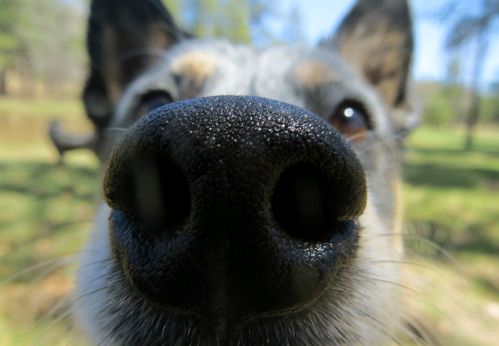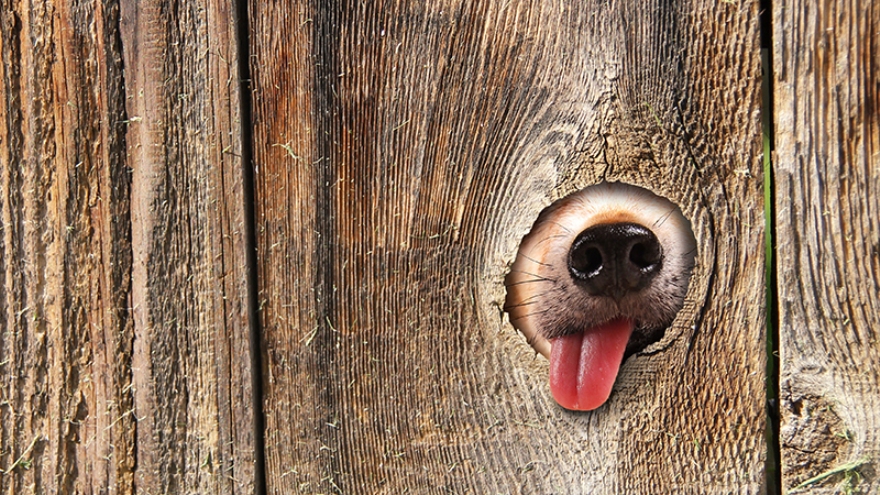

In this month's Oddities in the News Page:
Scientists study dog noses
IN THE ODDITIES ARCHIVES
Fisherman’s Unique Catch
Dr. Helen Sharman
Banana Art
Twinkie
What’s really in Loch Ness
Shark Tooth DNA
Military Admits to UFOs


Researchers believe they have solved the mystery surrounding dogs' noses and why they are so cold.
Sky News, March 9, 2020 -- A study revealed the phenomenon is down to their sniffers serving as ultra-sensitive heat detectors - and not anything to do with body temperature regulation.
Scientists in Sweden and Hungary found that when the ambient temperature was 85 degrees, a dog's rhinarium - or the bare end point of the nose - was 41 degrees cooler.
And when the outside temperature was at freezine, a dog's nose would be about 46 degrees. The two factors equal out at 59 degrees.
Such differences suggest the tip of the nose serves as a sensory function that can be hotter or colder than the outside temperature, according to the study published in the Scientific Reports journal.
It showed a dog's nose can detect very faint heat sources (such as small animals) from 5 feet away.
Researchers from Lund University and Eotvos Larand University studied three dogs, who were trained to identify which of two identical four-inch wide objects had been heated 53 degrees warmer than room temperature.
"All three dogs could detect stimuli of weak thermal radiation in double-blind experiments," said the researchers.
"In addition, we employed functional magnetic resonance imaging on 13 awake dogs, comparing the responses to heat stimuli of about the same temperatures as in the behavioural experiment. The warm stimulus elicited increased neural response.
"All stimuli of radiating heat used in our experiments were too weak to be felt by human hands, even at very short distances. We had to touch the surfaces to feel the warmth."
See more HERE
What a Dog's Nose Can (and Can't) Tell You About Its Health
You might have heard that feeling a dog's nose can tell you about his health. Can a dog's health really be determined by the temperature and moisture of the nose?
Does a cold and wet nose mean a dog is healthy? Is a warm and dry nose a sign of illness?
Here's the truth: The temperature or moisture of a dog's nose is not necessarily a good indicator of anything. A healthy dog may have a warm or dry nose while a sick dog could still have a cold, wet nose.
Your Dog's Nose
Dogs keep their noses cold and wet by licking. The moisture on the nose helps intensify scents and give dogs the ability to determine which directions smells are coming from.
It is normal for a dog that has just woken up to have a dry nose. This is simply because the dog was not licking his nose in his sleep.
Sometimes, a dog's dry or warm nose will accompany other signs of illness, such as lethargy, vomiting, diarrhea, and more. These symptoms are reason enough to call your vet, regardless of how your dog's nose feels.
Why Do People Think The Dog's Nose Matters?
The "dog nose" myth has been around for ages, sometimes putting dog owners in a panic. How did it begin? Like many myths, the origin of this one is not certain.
However, some experts think it may have started at a time when the deadly virus called canine distemper was common. One symptom of advanced distemper is hyperkeratosis (thickening) of the nose and footpads. Back when distemper was more widespread, a cool, wet nose was considered a good sign that the dog did not have distemper. While canine distemper still occurs, it is far less common today thanks to vaccines.
There are some medical conditions that can affect a dog's nose, causing it to appear abnormal. Some are more major than others. Pemphigus foliaceous is a serious dermatological condition that can cause a dog's nose to become very dry and cracked. Sometimes, a dog's nose can be affected by allergies, potentially causing dryness and cracking, though to a less serious extent. Be aware that dogs can get a sunburn, something that will affect the nose. There can also be pigment changes to your dog's nose, many of which are harmless. However, you should not ignore obvious changes to your dog's nose. Cracks, crusts, or sores on your dog's nose should be checked by your veterinarian as soon as possible. In addition, you should also contact your vet if your dog has nasal discharge, sneezing, or wheezing.
The bottom line: If your dog's nose happens to be dry or warm but otherwise looks normal, don't panic. However, you should contact your veterinarian right away if something does not seem right with your dog.
To see more, go HERE